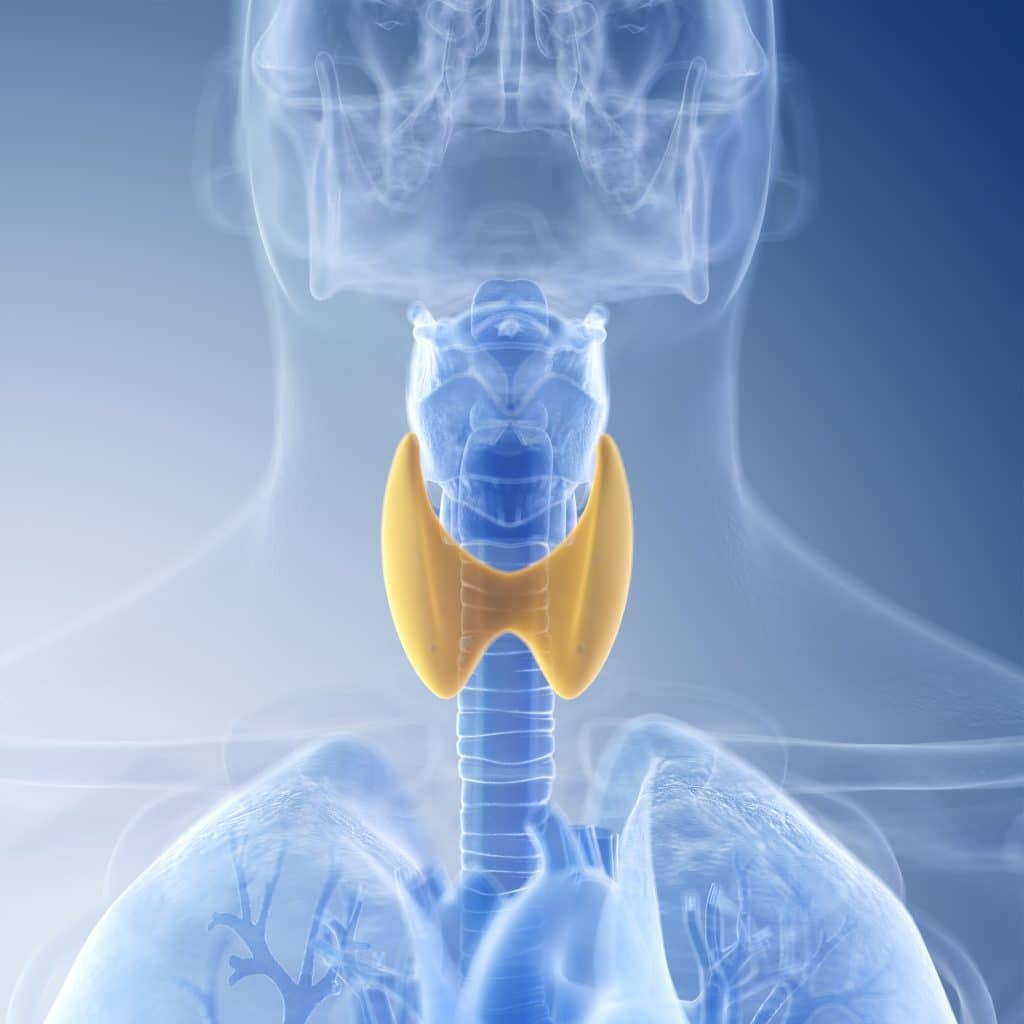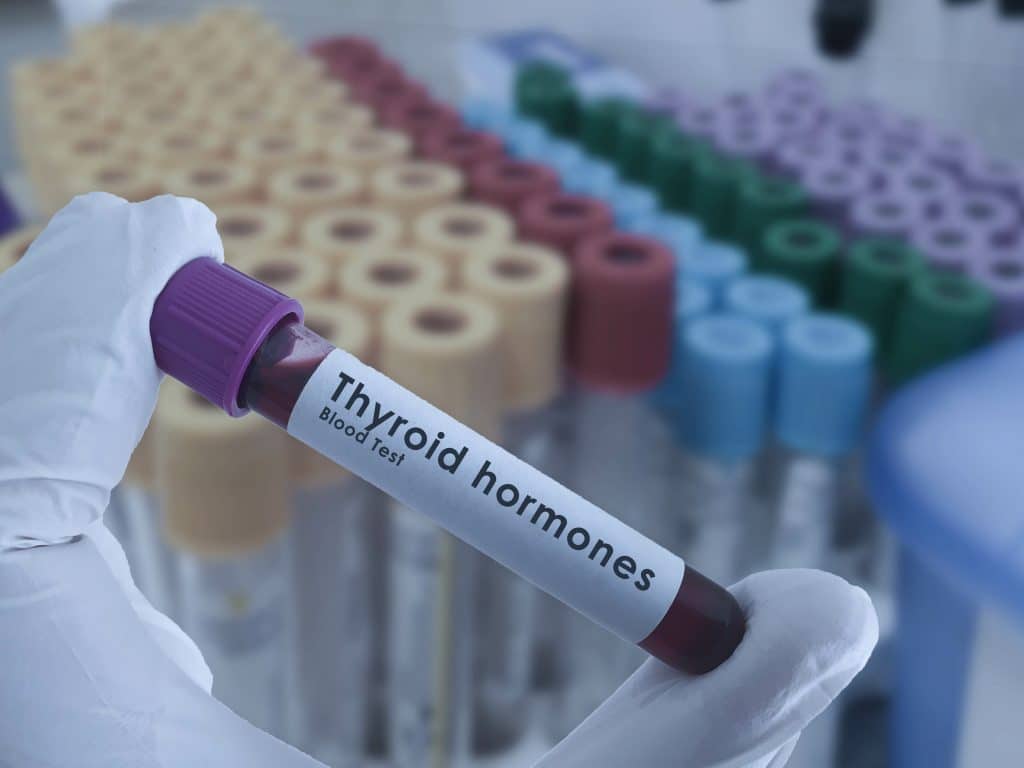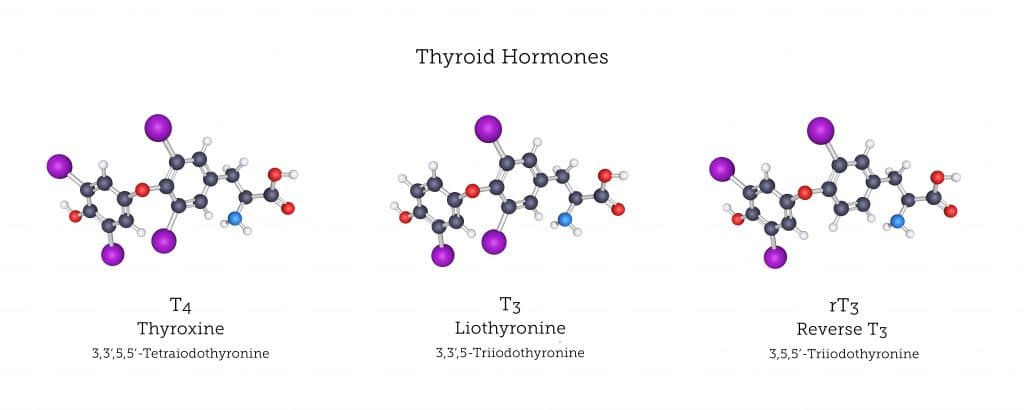Thyroid Disorders Lead To Weight Gain, Fatigue, Depression, Dry Skin, Hair Loss, And Hot Flashes
The thyroid is a small, butterfly-shaped gland located in the front of the neck, just below your Adam’s apple. It produces two hormones that help regulate many functions in the body. These hormones are triiodothyronine (T3) and thyroxine (T4). Most thyroid disorders stem from issues with T3 conversion or T3 resistance. The thyroid produces these hormones by taking iodine from the food you eat, combining it with the amino acid tyrosine, and then converting it into the hormones. These hormones travel through your bloodstream to tissues and organs throughout your body.
The hormones produced by the thyroid help regulate several bodily functions, including metabolism, heart rate, blood pressure, body temperature, reproductive function, and growth. Thyroid hormones also help the body use energy and convert food into energy. When the thyroid doesn’t produce enough of these hormones, it can cause a condition known as hypothyroidism. Conversely, when the thyroid produces too much hormone, it can lead to hyperthyroidism. Both conditions can cause symptoms such as fatigue, weight gain or loss, dry skin, thinning hair, and changes in mood.1
The Thyroid – What Is TSH, T4, And T3?
Thyroid-stimulating hormone (TSH) is a hormone that is produced by the pituitary gland in response to signals from the hypothalamus. It stimulates the thyroid gland to produce triiodothyronine (T3) and thyroxine (T4). T3 and T4 are hormones produced by the thyroid gland in response to signals from TSH. T3 is the active version of thyroid hormone and has a shorter half-life than T4.2

The medical establishment believes that TSH levels are a good indicator of how well the thyroid is functioning. This is why the TSH blood test is considered to be the gold standard to analyze thyroid function. However, there’s much more to it than that, as you will soon see.
Why Do So Many People Suffer From Thyroid Disorders?
An estimated 27 million people in the United States suffer from thyroid disorders. However, 13 million of these individuals don’t even realize they suffer from thyroid-related issues.3
A thyroid disorder is the number 1 most under-diagnosed condition. The problem is so severe that 4.6% of the US population over the age of 12 has hypothyroidism, meaning the thyroid is underactive.1
Symptoms Of Thyroid Disorders
The symptoms of thyroid disorders include sudden weight gain, hot flashes, thinning hair, dry skin, constant fatigue, depression, and infertility.4
If you have these symptoms, yet don’t understand why, an undiagnosed thyroid disorder may be to blame.
These symptoms stem from an issue with T3, the active version of the thyroid hormone. T3 assists cells to burn fat for energy, improve the skin, and maintain healthy hair growth.
Diagnosing Thyroid Disorders
As stated before, diagnosing thyroid disorders is generally done with the TSH blood test. If TSH is normal, the assumption is that the entire system is functioning properly. However, using this method allows many thyroid disorders to go undiagnosed for as long as 20 or 30 years before TSH levels change dramatically. During this time, your doctor will insist that you are healthy, but that doesn’t change the fact you are suffering from the symptoms of a thyroid disorder.

What Are The Real Reasons For Thyroid Dysfunction?
There are three main reasons for thyroid disorders. First, T4 is not converting into T3, the active version of thyroid hormone. Second, inflammation is reducing the level of circulating T3 and T3 is not able to bind to thyroid receptors located on the cellular membrane of cells. Third, Hashimoto’s disease, an autoimmune condition, is attacking the thyroid gland.
#1 Reason For Thyroid Disorders – T4 Is Not Converting Into T3
If T4 is not converting into T3, it is unable to relay its message to the cells no matter how much T4 is circulating through the blood. Unfortunately, the typical treatment option is to administer synthetic T4 like thyroxine or Synthroid to push TSH levels into the normal range, but this does nothing to address the actual problem.
T4 is converted into T3 in the liver so if the liver is under stress, it cannot perform its job properly. When the liver is under significant stress, whether that is physical, chemical, or emotional, it converts T4 into rT3. rT3 is an isomer of T3 that binds to cell receptors, effectively blocking T3 from binding to those receptors and relaying its message to the cells. The reason the body does this is to conserve energy during times of significant stress.5

While this doesn’t cause catastrophic consequences over a short time frame, the chronic production of rT3 leads to rT3 dominance, and therefore, T3 is unable to exert its action. When looking at basic TSH blood tests, it may look normal unless one focuses on the ratio between free T3 and rT3. If the body is undergoing chronic stress, a closer look at adrenal gland function may be in order.
#2 Reason For Thyroid Disorders – Chronic Inflammation Reduces Free T3
Chronic inflammation that generally stems from environmental toxins like heavy metals and mold exposure has been linked with a long list of degenerative diseases.6 Inflammation reduces the amount of active T3 available. For instance, high levels of inflammatory markers like interleukin-6, tumor necrosis factor, C-reactive protein, and interferon-alpha have all been associated with low levels of circulating T3.7 8 9 10
Inflammation also affects thyroid receptors on the cellular membrane, making it harder or even impossible for them to dock and relay their message into the cell. In this way, thyroid hormone resistance is similar to insulin resistance, as the T3 is functional and circulating, but isn’t able to communicate with the cells.
In short, we must address the factors that are causing inflammation if we want to get a handle on thyroid disorders.
#3 Reason For Thyroid Disorders – Hashimoto’s Disease
Hashimoto’s Disease is characterized by an autoimmune attack on the thyroid gland that results in hypothyroidism. It is often diagnosed after a patient has been experiencing symptoms for some time and tests reveal elevated levels of antibodies against their own thyroid tissue.
The most common symptoms of Hashimoto’s Disease are fatigue, weight gain or difficulty losing weight, constipation, dry skin, feeling cold easily, and depression. Hashimoto’s is believed to be caused by an underlying food intolerance that has gone undetected for some time, resulting in a weakened immune system which then causes the body to attack itself.11
90% of hypothyroidism stems from autoimmune causes so we must get to the underlying cause if we wish to receive relief.12 People who suffer from Hashimoto’s Disease often have issues with IBS, Crohn’s, Celiac, and Leaky Gut as well.13
If blood work is normal indicating proper TSH levels, most doctors don’t check for Hashimoto’s Disease because treatment is the same, Thyroxin or Synthroid.
Association Between Thyroid Disorders
A study comparing the levels of thyroid hormones between individuals with impaired fasting glucose (IFG) and those with impaired glucose tolerance (IGT) found that subjects with IFG had significantly higher levels of F3, a form of triiodothyronine, than those with IGT. This suggests that thyroid hormone levels affect glucose homeostasis and the development of metabolic disorders.14
Fasting And The Thyroid
If you have followed my work for a while you know that I am a big proponent of fasting as a way to reset the body and allow it to heal itself. As you may have guessed, fasting is the best option to improve thyroid function. Fasting decreases inflammation and thereby improves the function of thyroid receptors.15
Fasting allows the liver a chance to remove built-up fat deposits, and various other stressors. Even a short-term fast significantly improves liver function. While serum T3 levels fall during a fast,16 they quickly rebound after breaking the fast.

A better functioning liver facilitates the efficient conversion between T4 into T3 going forward. Fasting is only one-half of the solution, as feasting is required to build the body back up. If we consider the way our ancestors ate when they were hunting and gathering, we can understand why we should stick to a similar cycle of feasting and fasting. If you are suffering from a thyroid disorder, consider following this weekly fasting and feasting diet.
Diet Variation 3-2-2 For Thyroid Disorders
The 3-2-2 diet variation consists of 3 days of intermittent fasting, 2 days of water fasting, and 2 days of feasting. During the first 3 days of intermittent fasting, limit the window when you consume all of your calories to somewhere between 4 hours and 10 hours. Next, spend 2 days on a water fast and then the next 2 days feasting, eating enough calories to overcome the 2 fasting days. While it may seem hard or even impossible to follow this diet, the difference you will notice in your health will be immediately apparent and only improve with time, if you can stick with it.
Read more about the benefits of fasting.
There Is Hope For Dealing With Thyroid Disorders
If you are suffering from the symptoms of thyroid disorders, there is hope. In many individuals, simply fasting on a regular basis can restore hormone balance and reduce or even eliminate the symptoms of thyroid dysfunction. At the very core, we need to target what is behind chronic inflammation if we are to restore the endocrine system as a whole and eliminate autoimmune conditions.
References
1 Hypothyroidism (Underactive Thyroid). (2022, November 16). National Institute of Diabetes and Digestive and Kidney Diseases. https://www.niddk.nih.gov/health-information/endocrine-diseases/hypothyroidism
2 InformedHealth.org [Internet]. Cologne, Germany: Institute for Quality and Efficiency in Health Care (IQWiG); 2006-. How does the thyroid gland work? 2010 Nov 17 [Updated 2018 Apr 19]. Available from: https://www.ncbi.nlm.nih.gov/books/NBK279388/
3 Blackwell J. Evaluation and treatment of hyperthyroidism and hypothyroidism. J Am Acad Nurse Pract. 2004 Oct;16(10):422-5. doi: 10.1111/j.1745-7599.2004.tb00418.x. PMID: 15543918.
4 Thyroid Disorders. (2022, October 28). Johns Hopkins Medicine. https://www.hopkinsmedicine.org/health/conditions-and-diseases/disorders-of-the-thyroid
5 Peeters RP, Visser TJ. Metabolism of Thyroid Hormone. [Updated 2017 Jan 1]. In: Feingold KR, Anawalt B, Boyce A, et al., editors. Endotext [Internet]. South Dartmouth (MA): MDText.com, Inc.; 2000-. Available from: https://www.ncbi.nlm.nih.gov/books/NBK285545/
6 Aksentijevich M, Lateef SS, Anzenberg P, Dey AK, Mehta NN. Chronic inflammation, cardiometabolic diseases and effects of treatment: Psoriasis as a human model. Trends Cardiovasc Med. 2020 Nov;30(8):472-478. doi: 10.1016/j.tcm.2019.11.001. Epub 2019 Nov 20. PMID: 31837960; PMCID: PMC7428846.
7 Boelen A, Platvoet-Ter Schiphorst MC, Wiersinga WM. Association between serum interleukin-6 and serum 3,5,3′-triiodothyronine in nonthyroidal illness. J Clin Endocrinol Metab. 1993 Dec;77(6):1695-9. doi: 10.1210/jcem.77.6.8263160. PMID: 8263160.
8 van der Poll T, Romijn JA, Wiersinga WM, Sauerwein HP. Tumor necrosis factor: a putative mediator of the sick euthyroid syndrome in man. J Clin Endocrinol Metab. 1990 Dec;71(6):1567-72. doi: 10.1210/jcem-71-6-1567. PMID: 2229314.
9 Razvi S, Jabbar A, Bano A, Ingoe L, Carey P, Junejo S, Thomas H, Addison C, Austin D, Greenwood JP, Zaman AG. Triiodothyronine (T3), inflammation and mortality risk in patients with acute myocardial infarction. Eur Thyroid J. 2022 Feb 9;11(2):e210085. doi: 10.1530/ETJ-21-0085. PMID: 35007210; PMCID: PMC9142797.
10 Corssmit EP, Heyligenberg R, Endert E, Sauerwein HP, Romijn JA. Acute effects of interferon-alpha administration on thyroid hormone metabolism in healthy men. J Clin Endocrinol Metab. 1995 Nov;80(11):3140-4. doi: 10.1210/jcem.80.11.7593416. PMID: 7593416.
11 Hashimoto’s Disease. (2022, November 16). National Institute of Diabetes and Digestive and Kidney Diseases. https://www.niddk.nih.gov/health-information/endocrine-diseases/hashimotos-disease?dkrd=hispt0297
12 Amino N. Autoimmunity and hypothyroidism. Baillieres Clin Endocrinol Metab. 1988 Aug;2(3):591-617. doi: 10.1016/s0950-351x(88)80055-7. PMID: 3066320.
13 Abbott, R. D., Sadowski, A., & Alt, A. G. (2019). Efficacy of the Autoimmune Protocol Diet as Part of a Multi-disciplinary, Supported Lifestyle Intervention for Hashimoto’s Thyroiditis. Cureus, 11(4), e4556. https://doi.org/10.7759/cureus.4556
14 Jing S, Xiaoying D, Ying X, Rui L, Mingyu G, Yuting C, Yanhua Y, Yufan W, Haiyan S, Yongde P. Different levels of thyroid hormones between impaired fasting glucose and impaired glucose tolerance: free T3 affects the prevalence of impaired fasting glucose and impaired glucose tolerance in opposite ways. Clin Endocrinol (Oxf). 2014 Jun;80(6):890-8. doi: 10.1111/cen.12384. Epub 2014 Jan 16. PMID: 24330392.
15 Exploring how fasting blunts inflammation | NIH Intramural Research Program. (2021). https://irp.nih.gov/accomplishments/exploring-how-fasting-blunts-inflammation
16 Wu SY. The effect of fasting on thyroidal T4-5′ monodeiodinating activity in mice. Acta Endocrinol (Copenh). 1990 Feb;122(2):175-80. doi: 10.1530/acta.0.1220175. PMID: 2316308.




